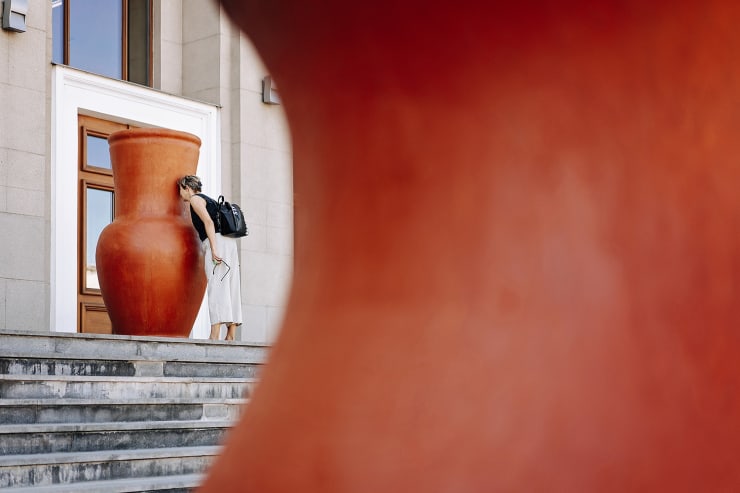Mykola Ridnyi "Lost Baggage": Location: Courtyard of Lithuanian Theater, Music and Cinema Museum
Project dedicated to commemorate the Vilnius Gaon and the Jewish Year in Lithuania
LOST BAGGAGE, 2019
Commissioned for the 12-th Kaunas biennial in 2019. The installation is inspired by the figure of Esther Lurie, an artist who was one of the Kaunas ghetto prisoners to survive to the Holocaust. Lurie made a series of drawings that show the characters, life conditions and streets of the Ghetto, which used to be populated by 30000 people. Some of her works have been lost, then she made new versions (replicas) after the war. According to evidences, she hid the drawings in ceramic pots and buried them in the ground to conceal them from the Nazis. Nevertheless, they were never found, as this story turned into a legend.
In his installation, Ridnyi secretes Lurie’s images into five human size ceramic pots. Ceramic is chosen as a material because of the long craft tradition that characterizes the city of Kaunas, together with its textile industry. Visitors can only spot the drawings by using small peepholes on the pots’ surfaces.
We are grateful to Kaunas biennial and Kaunas Ninth Fort Museum for collaboration
Gallery Patron
Renata and Rolandas Valiūnas
Gallery supported by
Vilnius City Municipality
Lietuvos Rytas
Vilma Dagilienė
Romas Kinka
Art Fund
Ekskomisarų biuras
MYKOLA RIDNYI
LOST BAGGAGE, 2019
Commissioned for the 12-th Kaunas biennial in 2019. The installation is inspired by the figure of Esther Lurie, an artist who was one of the Kaunas ghetto prisoners to survive to the Holocaust. Lurie made a series of drawings that show the characters, life conditions and streets of the Ghetto, which used to be populated by 30000 people. Some of her works have been lost, then she made new versions (replicas) after the war. According to evidences, she hid the drawings in ceramic pots and buried them in the ground to conceal them from the Nazis. Nevertheless, they were never found, as this story turned into a legend.
In his installation, Ridnyi secretes Lurie’s images into five human size ceramic pots. Ceramic is chosen as a material because of the long craft tradition that characterizes the city of Kaunas, together with its textile industry. Visitors can only spot the drawings by using small peepholes on the pots’ surfaces.
The images embody the dark side of Kaunas history and Jewish minority. The hidden position for private evidences of the Holocaust problematizes ideas of displacement, forgetting, removal by and from official narratives in different periods of history. The monumental shape gives to fragile and domestic objects a public and political dimension. The permanent location of the work - the Kaunas train station - underlines the dramatic idea of the baggage which traveler is not allowed to take into a journey, a baggage which can cost a life.
The project was supported by Lithuanian Council for Culture, Ukraine Institute and Kaunas municipality. The work has been realised in collaboration with Vilnius Academy of Arts Kaunas Faculty Department of Ceramics.






